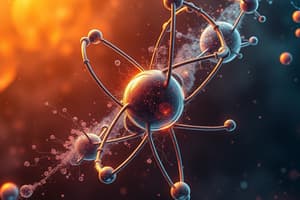Podcast
Questions and Answers
What is a proton?
What is a proton?
A positively charged subatomic particle found in the nucleus of an atom.
What is a neutron?
What is a neutron?
A neutral subatomic particle found in the nucleus of an atom.
What is an electron?
What is an electron?
A negatively charged subatomic particle that orbits the nucleus of an atom.
What type of charge does a proton have?
What type of charge does a proton have?
What type of charge does a neutron have?
What type of charge does a neutron have?
What type of charge does an electron have?
What type of charge does an electron have?
Which two substances are located in the nucleus of an atom?
Which two substances are located in the nucleus of an atom?
If an atom has 35 protons in the nucleus, how many electrons will it have orbiting the nucleus?
If an atom has 35 protons in the nucleus, how many electrons will it have orbiting the nucleus?
What is the atomic number of the atom in the diagram above?
What is the atomic number of the atom in the diagram above?
What is the atomic mass/mass number of the atom in the diagram above?
What is the atomic mass/mass number of the atom in the diagram above?
How many protons are in the nucleus of an atom with an atomic number of 15?
How many protons are in the nucleus of an atom with an atomic number of 15?
How many electrons are in the nucleus of an atom with an atomic number of 15?
How many electrons are in the nucleus of an atom with an atomic number of 15?
How many neutrons are in the nucleus of an atom with an atomic number of 25?
How many neutrons are in the nucleus of an atom with an atomic number of 25?
What is the mass number of an atom with 3 protons, 4 neutrons, and 3 electrons?
What is the mass number of an atom with 3 protons, 4 neutrons, and 3 electrons?
How many neutrons are in the nucleus of an atom that has an atomic mass of 36 and an atomic number of 25?
How many neutrons are in the nucleus of an atom that has an atomic mass of 36 and an atomic number of 25?
Flashcards
What is a proton?
What is a proton?
A positively charged subatomic particle in the nucleus.
What is a neutron?
What is a neutron?
A neutral subatomic particle found in the nucleus.
What is an electron?
What is an electron?
A negatively charged subatomic particle orbiting the nucleus.
Proton Charge
Proton Charge
Signup and view all the flashcards
Neutron Charge
Neutron Charge
Signup and view all the flashcards
Electron Charge
Electron Charge
Signup and view all the flashcards
Nucleus Contents
Nucleus Contents
Signup and view all the flashcards
Electrons with 35 Protons
Electrons with 35 Protons
Signup and view all the flashcards
Atomic Number
Atomic Number
Signup and view all the flashcards
Atomic Mass/Mass Number
Atomic Mass/Mass Number
Signup and view all the flashcards
Protons in Atomic Number 15
Protons in Atomic Number 15
Signup and view all the flashcards
Mass Number Calculation
Mass Number Calculation
Signup and view all the flashcards
Neutrons Calculation
Neutrons Calculation
Signup and view all the flashcards
Study Notes
Atomic Structure Key Concepts
- Protons are positively charged subatomic particles found in the nucleus of an atom.
- Neutrons are neutral particles, part of the nucleus, and do not have a charge.
- Electrons are negatively charged subatomic particles that orbit the nucleus.
Charges of Subatomic Particles
- Protons carry a positive charge.
- Neutrons possess no charge (neutral).
- Electrons have a negative charge.
Atomic Composition
- Protons and neutrons are the two substances located in the nucleus of an atom.
- The electron count in a neutral atom equals the number of protons.
Atomic Numbers and Mass
- The atomic number corresponds to the number of protons in an atom’s nucleus.
- Example: An atom with 35 protons will also have 35 electrons orbiting it.
- Atomic mass or mass number is the total number of protons and neutrons in the nucleus.
Calculating Subatomic Particles
- For an atom with an atomic number of 15, there will be 15 protons.
- The number of electrons equals the number of protons in a neutral atom.
- The number of neutrons can be calculated by subtracting the atomic number from the atomic mass.
Mass Number Examples
- An atom with 3 protons, 4 neutrons, and 3 electrons has a mass number of 7 (3 protons + 4 neutrons).
- For an atom with an atomic mass of 36 and an atomic number of 25, it has 11 neutrons (36 - 25 = 11).
Studying That Suits You
Use AI to generate personalized quizzes and flashcards to suit your learning preferences.




